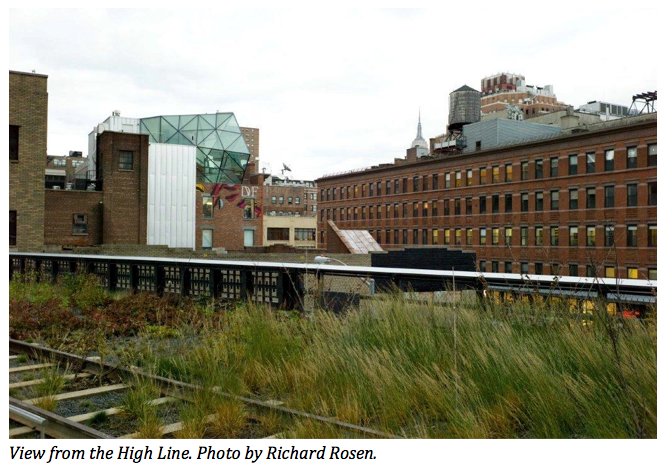By Sharon Zukin
Shortly before 8 p.m. on a warm September evening the High Line, Manhattan’s newest public park and the only one located above street level, is crowded. Men and women, old and young, tourists from overseas and longtime New Yorkers have climbed the winding metal stairs to the former railroad freight line, now a mile-long, landscaped walkway, just to view the sunset over the Hudson River. There are more people up on the High Line than down on the streets. They are taking photos, chatting quietly, lounging on wooden benches and strolling between shallow beds of native plants, creating a new passagiata for the post-industrial city.
 There’s a lot to like about the High Line. It’s a gritty fragment of New York’s industrial past that was saved from demolition by feisty activists and wholesome volunteers. It makes us think about how the city’s architecture was once built for function rather than for style. It reminds us of what the rough West Side of Manhattan was like before a derelict Nabisco plant, where assembly line bakers manufactured the first branded American cracker, was transformed into the high-class bread shops of Chelsea Market. And it recalls the days, not so long ago, when the Meatpacking District was a no-go zone for animal carcasses, blood-stained butchers and several kinds of street workers who made their nocturnal rounds, a far cry from the attraction for club kids and fashionistas it has become.
There’s a lot to like about the High Line. It’s a gritty fragment of New York’s industrial past that was saved from demolition by feisty activists and wholesome volunteers. It makes us think about how the city’s architecture was once built for function rather than for style. It reminds us of what the rough West Side of Manhattan was like before a derelict Nabisco plant, where assembly line bakers manufactured the first branded American cracker, was transformed into the high-class bread shops of Chelsea Market. And it recalls the days, not so long ago, when the Meatpacking District was a no-go zone for animal carcasses, blood-stained butchers and several kinds of street workers who made their nocturnal rounds, a far cry from the attraction for club kids and fashionistas it has become.
The High Line offers New Yorkers a novel way to indulge in two things that have become a passion since 9/11: spending time out-of-doors and hanging out in public spaces. Maybe it reflects a hunger for community or maybe it’s a behavioral response to global warming, but this desire to be together in public flouts the ever-present eye of the surveillance cameras and revels in the diversity of strangers. It’s the same passion that drives apartment dwellers to socialize on their building’s roof and eat lunch in the new “traffic-calming” islands that have been carved out of Broadway’s tumult.
While the number of people who use the city’s public parks has grown enormously in recent years, the High Line attracts a disproportionately huge number of visitors, as many as half a million in the first two months after it opened in 2009.
But this is what it took to “save” it: A mayor – Michael Bloomberg – who understands the value of attractive green space to brand the city for tourists and residents alike. A city planning commissioner, Amanda Burden, who shares the city-branding vision and speaks the language of historic preservation. A longtime strategy of “adaptive re-use” to find new business uses for old historic structures and an emerging strategy of “self-financing” for public parks, both of which rely on private funding. Most important, saving the High Line depended on powerful backers in the “creative class” of art, media and fashion who have their own interest in redeveloping the neighborhood—in this case, the power couple of Diane vo


